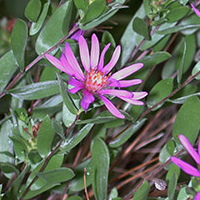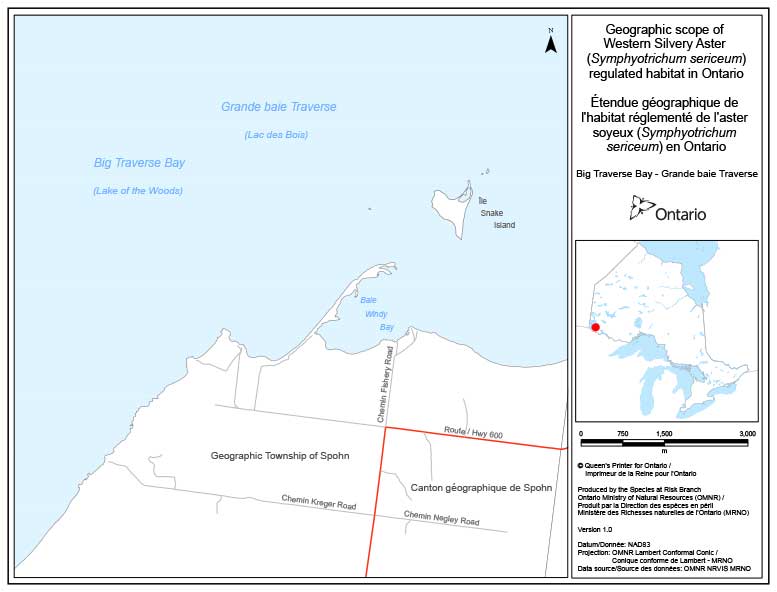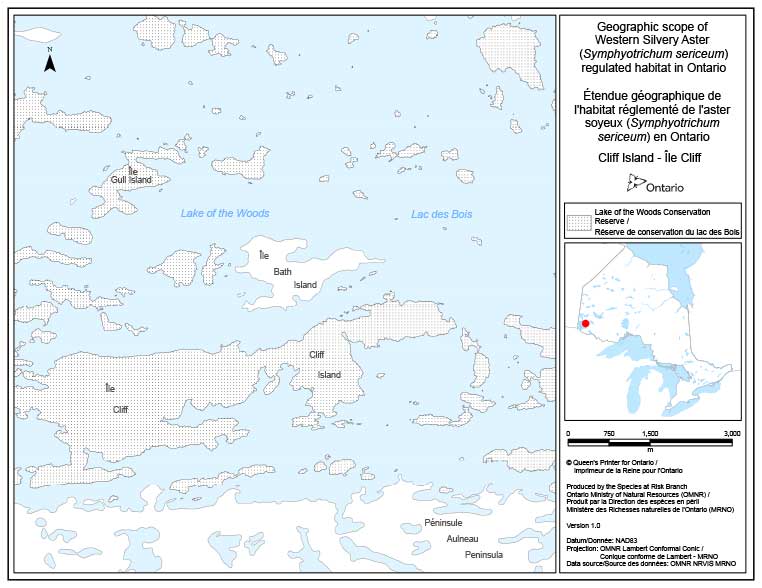Western Silvery Aster
Scientific name: Symphyotrichum sericeum

Photo credit: M. J. Oldham
Status
Threatened
“Threatened” means the species lives in the wild in Ontario, is not endangered, but is likely to become endangered if steps are not taken to address factors threatening it.
Date added to the Species at Risk in Ontario List
The Western Silvery Aster was already assessed as at risk when the Endangered Species Act, 2007 took effect in 2008.
Read the most recent assessment report (PDF).
What it looks like
Considered by some botanists to be one of the prettiest members of the aster family, the Western Silvery Aster is a perennial wildflower native to Ontario. It is most noticeable in the fall when it flowers.
The stalks can grow up to 70 cm, with leaves that are covered in fine hairs (hence the silver appearance). Flowers are pink or pale purple and become redder as they age.
Where it lives
The Western Silvery Aster grows in open bur oak savannahs on shallow soils over bedrock. It is found with other prairie species.
The range of the Western Silvery Aster in central North America extends from Texas to Michigan and Manitoba.
Where it’s been found in Ontario
In Ontario, the Western Silvery Aster grows in just three areas: on the south shore of Lake of the Woods and on two islands within the lake.
What threatens it
Like most species at risk, the loss and destruction of habitat is a cause for the decline in Western Silvery Aster numbers.
Other threats to Western Silvery Aster include:
- development
- mining and quarrying
- roadside and right-of-way maintenance
- disruption of natural disturbance regimes
- invasive species
Action we are taking
This species and its habitat are protected under Ontario’s Endangered Species Act, 2007 (ESA).
The ESA also requires us to prepare recovery guidance for threatened species such as Western Silvery Aster to guide recovery efforts for the species in Ontario.
All species listed on the Species at Risk in Ontario List may be eligible for consideration for government funding through the Species at Risk Stewardship Program.
Recovery Strategy
A recovery strategy advises the ministry on ways to ensure healthy numbers of the species return to Ontario.
Read the executive summary and the full document (December 7, 2018).
Government response statement
A government response statement outlines the actions the government intends to take or support to help recover the species.
Read the government response statement (September 5, 2019).
Review of progress
A review of progress made toward protecting and recovering a species is required no later than the time specified in the species’ government response statement, or not later than five years after the government response statement is published if no time is specified.
Read the report on progress towards the protection and recovery of 12 species at risk, including Western Silvery Aster (2024).
Habitat protection
A habitat regulation defines a species' habitat and may describe features (such as a creek, cliff, or beach), geographic boundaries or other unique characteristics.
Read the regulation (February 18, 2010; amended September 14, 2016)
Habitat regulation maps
A habitat regulation map depicts the areas prescribed as the habitat of the species by Ontario Regulation 832/21 under the Endangered Species Act, 2007. The Western Silvery Aster habitat regulation maps must be read in conjunction with the full text of Section 33 of Ontario Regulation 832/21.
Geographic scope of Western Silvery Aster (Symphyotrichum sericeum) regulated habitat in Ontario – Big Traverse Bay
View a larger version of this copy (PDF)
Geographic scope of Western Silvery Aster (Symphyotrichum sericeum) regulated habitat in Ontario – Cliff Island
View a larger version of this copy (PDF)
February 2010 maps
The maps published on February 18, 2010 that depict the areas prescribed as the habitat of Western Silvery Aster by Section 33 of Ontario Regulation 832/21 are filed in the office of the Surveyor General. The 2010 maps are identical to the 2016 maps with the exception of an administrative amendment. Requests for electronic copies of the 2010 maps may be sent to recovery.planning@ontario.ca.
What you can do
Report a sighting
Submit your observations of species at risk to the Natural Heritage Information Centre (NHIC), which is Ontario’s conservation data centre. Join the centre’s Rare Species of Ontario project in iNaturalist, an online plant and animal identification app, to quickly and easily submit your observations.
Volunteer
Volunteer with your local nature club or provincial park to participate in surveys or stewardship work focused on species at risk.
Be a good steward
- Private landowners have a very important role to play in species recovery. If you find species at risk on your land, you may be eligible for stewardship programs that support the protection and recovery of species at risk and their habitats, such as the Species at Risk Stewardship Program.
- Invasive species seriously threaten many of Ontario’s species at risk. To learn what you can do to help reduce the threat of invasive species, visit:
Report illegal activity
Report any illegal activity related to plants and wildlife to
Quick facts
- The Western Silvery Aster is Ontario’s rarest aster; it grows in bur oak savannahs, which is a provincially rare type of habitat.
- This plant has a long history; it likely migrated to the northwest around 6,000-8,000 years ago, when prairies expanded eastward and Woodland Buffalo roamed the Kenora area.

